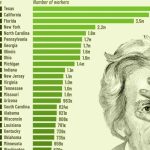The U.S. economy rebounded substantially in the second quarter, exceeding economists’ expectations.
This is up from the previous quarter’s 0.6 percent contraction—adjusted lower from 0.5 percent—and came in above the market consensus of 3.3 percent.
“GDP is growing at +3.8% in real terms, so despite the elevated inflation we have been living with since COVID, economic growth is exceeding that by a very large margin,” Chris Zaccarelli, chief investment officer for Northlight Asset Management, said in a note emailed to The Epoch Times.
The economy’s overall recovery in the April–June period was fueled by a sharp decline in imports and an increase in consumer spending.
“Real GDP was revised up 0.5 percentage point from the second estimate, primarily reflecting an upward revision to consumer spending,” the agency said.
Imports fell by more than 29 percent following a 38 percent spike in the January–March span. Falling imports of foreign merchandise can boost gross domestic product since the quarterly metric measures spending on goods and services produced domestically.
Exports fell by 1.8 percent after a 0.2 percent boost in the first quarter.
President Donald Trump’s global tariffs prompted companies to front-load their purchases of foreign products ahead of the administration’s levies.
Government consumption expenditures and gross investment dipped 0.1 percent for the second consecutive quarter, led by a 5.3 percent decline in federal spending. State and local outlays, however, rose by about 3 percent.
At an industrial level, meanwhile, the bureau reported a 10.2 percent increase in real value added for private goods-producing industries and a 3.5 percent jump in private services-producing sectors. This helped offset the 3.2 percent drop in real value added for government.
On the inflation front, the increase in the GDP Price Index—a gauge of prices of all goods and services in the GDP—slowed to a slightly higher than expected 2.1 percent in the second quarter, from the 3.6 percent increase in the previous quarter.
In addition, inflation in Personal Consumption Expenditures (PCE) Prices also eased to 2.1 percent in the second quarter, from 3.7 percent. This came in a bit above the 2 percent reading. The final reading for core PCE price inflation, which strips out the volatile energy and food components, was higher than expected at 2.6 percent, down from 3.5 percent.
The U.S. economy is expected to continue expanding in the third quarter.
Other Robust Economic Indicators
The U.S. labor market continued to send mixed signals this week.
For the week ending Sept. 20, initial jobless claims—the number of individuals filing new applications for unemployment benefits—declined by 14,000 to a two-month low of 218,000, from the previous week’s 232,000.


Economists had penciled in a reading of 235,000.
Continuing jobless claims—a measure of the number of unemployed individuals currently receiving jobless benefits—fell to a smaller-than-expected 1.926 million.
The latest claims data could help alleviate concerns about deteriorating labor market conditions.
Federal Reserve Chair Jerome Powell stated this week that weaker employment data was the catalyst behind the U.S. central bank’s decision to lower interest rates for the first time this year at the September Federal Open Market Committee (FOMC) policy meeting.
The September nonfarm payrolls report will be released on Oct. 3, and early forecasts suggest the economy added 70,000 new jobs.
The increase was led by transport equipment (7.9 percent), specifically defense aircraft and parts (50.1 percent) and nondefense aircraft and parts (21.6 percent).
Excluding transportation, new orders increased by 0.4 percent. Durable goods orders, omitting defense, also advanced by 1.9 percent.
The next key piece of data will be the August Personal Consumption Expenditure (PCE) Price Index, the Fed’s preferred inflation measure.
“Given all the recent focus on rate cuts due to rising unemployment and negative revisions to jobs numbers, we get to focus back to the other key aspect of the Fed’s dual mandate this week in inflation,” Jay Woods, chief global strategist at Freedom Capital Markets, said in a note emailed to The Epoch Times.
Core PCE inflation, in the 12 months ending in August, is expected to rise to 3 percent from 2.9 percent.










